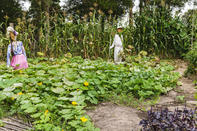Crop Rotation
Rotate with crops that are not of the same family as courgettes to prevent build-up of Cucurbit common pests and diseases.
Yield - tonnes per hectare
Conservative: 7 tonnes
Average: 12 tonnes
Good: 20+ tonnes
Harvesting
Courgette harvesting is done by hand with knives or shears. For baby courgettes, harvest when the fruit is between 12 cm and 15 cm in length. Some are even cut when the flower is still attached.
The larger courgettes are harvested when they are between 30 cm and 40 cm and are referred to as marrow. Other marrows can also be left to mature for seed production.
When harvesting the courgette from the plant, it is beneficial to cut it off in such a way as to retain a short piece of the stem (10-15 mm) on the harvested courgette. The moisture contained in this small section of attached stem helps to prevent post-harvest dehydration of the courgettes.
Harvest and move the baby marrows into a cool shed as quickly after harvest as possible. Handle the fruit with care as they are still immature fruit and the skin can easily be damaged, rendering the courgette unsalable as fresh produce. Once the fruit is in the packing facility it is graded and sorted and packed.
Slightly damaged and second class courgettes are sent for further processing or freezing.
Storage
Courgettes do not store well for periods longer than ten days. Storage processes should begin by removing field heat with hydro cooling or forced air cooling at a high relative humidity of above 95% to prevent dehydration as quickly as possible after harvest. After this, storage should be at 6°C to 8°C and 95% relative humidity for a maximum of ten days.
Courgettes are sensitive to chilling damage so take care not to allow exposure to temperatures below 6°C. Because the fruit is picked at an immature stage it is highly perishable and should be marketed as quickly as possible. Cold chain processes should be strictly adhered to until consumed.
Pests
Some common pests are: Aphids, cutworms, Epilachna beetle, fruit fly, leaf miners, red spider mite, thrips and white flyDiseases
Some common diseases are: Anthracnose, damping off, downey mildew, mosaic virus and powdery mildew.
With disease and pest control, it is always best practice to seek the advice and recommendations of the regional extension officer, agronomist and chemical specialists for crop protection preventative and curative practices.
Remember that prevention is better and cheaper than having to cure a problem.
By Louise Brodie